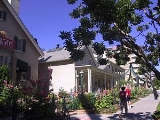
Brigham Young Complex
Encyclopedia
The Brigham Young Complex is the collective name given in the U.S.
National Historic Landmark
program to a set of two house
s in Salt Lake City
, Utah
. These houses were the residence of Brigham Young
from 1852 until his death in 1877. As President of The Church of Jesus Christ of Latter-day Saints at the time of the Mormon
settlement of the Salt Lake Valley
, Young and his home were pivotal in the development of the Church, Utah, and the American west
. The houses were designated as a National Historic Landmark in 1964.
The two houses that comprise the Brigham Young Complex are:
United States
The United States of America is a federal constitutional republic comprising fifty states and a federal district...
National Historic Landmark
National Historic Landmark
A National Historic Landmark is a building, site, structure, object, or district, that is officially recognized by the United States government for its historical significance...
program to a set of two house
House
A house is a building or structure that has the ability to be occupied for dwelling by human beings or other creatures. The term house includes many kinds of different dwellings ranging from rudimentary huts of nomadic tribes to free standing individual structures...
s in Salt Lake City
Salt Lake City, Utah
Salt Lake City is the capital and the most populous city of the U.S. state of Utah. The name of the city is often shortened to Salt Lake or SLC. With a population of 186,440 as of the 2010 Census, the city lies in the Salt Lake City metropolitan area, which has a total population of 1,124,197...
, Utah
Utah
Utah is a state in the Western United States. It was the 45th state to join the Union, on January 4, 1896. Approximately 80% of Utah's 2,763,885 people live along the Wasatch Front, centering on Salt Lake City. This leaves vast expanses of the state nearly uninhabited, making the population the...
. These houses were the residence of Brigham Young
Brigham Young
Brigham Young was an American leader in the Latter Day Saint movement and a settler of the Western United States. He was the President of The Church of Jesus Christ of Latter-day Saints from 1847 until his death in 1877, he founded Salt Lake City, and he served as the first governor of the Utah...
from 1852 until his death in 1877. As President of The Church of Jesus Christ of Latter-day Saints at the time of the Mormon
Mormon
The term Mormon most commonly denotes an adherent, practitioner, follower, or constituent of Mormonism, which is the largest branch of the Latter Day Saint movement in restorationist Christianity...
settlement of the Salt Lake Valley
Salt Lake Valley
Salt Lake Valley is a valley in Salt Lake County in the north-central portion of the U.S. state of Utah. It contains Salt Lake City and many of its suburbs, notably West Valley City, Murray, Sandy, and West Jordan; its total population is 1,029,655 as of 2010...
, Young and his home were pivotal in the development of the Church, Utah, and the American west
Western United States
.The Western United States, commonly referred to as the American West or simply "the West," traditionally refers to the region comprising the westernmost states of the United States. Because the U.S. expanded westward after its founding, the meaning of the West has evolved over time...
. The houses were designated as a National Historic Landmark in 1964.
The two houses that comprise the Brigham Young Complex are:
- The Beehive HouseBeehive HouseThe Beehive House is one of the two official residences of Brigham Young, an early leader of The Church of Jesus Christ of Latter-day Saints . The Beehive House gets its name from the Beehive sculpture atop the house. It was designed by Young's brother-in-law and architect of the Salt Lake...
- The Lion House

